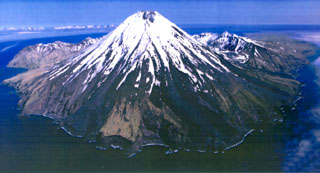Report on Kanaga (United States) — January 1994
Bulletin of the Global Volcanism Network, vol. 19, no. 1 (January 1994)
Managing Editor: Richard Wunderman.
Kanaga (United States) Low-level steam emissions with minor ash content
Please cite this report as:
Global Volcanism Program, 1994. Report on Kanaga (United States) (Wunderman, R., ed.). Bulletin of the Global Volcanism Network, 19:1. Smithsonian Institution. https://doi.org/10.5479/si.GVP.BGVN199401-311110
Kanaga
United States
51.923°N, 177.168°W; summit elev. 1307 m
All times are local (unless otherwise noted)
Low-level eruptive activity began in late December 1993. Unusual amounts of steam, ashfall on the flanks of the volcano, and sulfur smell in Adak . . . were reported through mid-January 1994. Pilots and observers in Adak also reported continued low-level emission of steam, and possibly minor ash, from Kanaga during the third week of January. Photographs taken by the U.S. Navy show two steam vents near the summit. Observers in Adak were unable to view Kanaga from 27 January through 18 February. However, the smell of sulfur was detected in early February.
Pilot reports indicated another eruption on 21 February with plume heights of 3.6-4.5 km, rising at times to 7.5 km altitude; ground observers reported a steam plume rising to 600-900 m altitude. Satellite data were inconclusive in detecting the plume.
Geological Summary. Symmetrical Kanaga stratovolcano is situated within the Kanaton caldera at the northern tip of Kanaga Island. The caldera rim forms a 760-m-high arcuate ridge south and east of Kanaga; a lake occupies part of the SE caldera floor. The volume of subaerial dacitic tuff is smaller than would typically be associated with caldera collapse, and deposits of a massive submarine debris avalanche associated with edifice collapse extend nearly 30 km to the NNW. Several fresh lava flows from historical or late prehistorical time descend the flanks of Kanaga, in some cases to the sea. Historical eruptions, most of which are poorly documented, have been recorded since 1763. Kanaga is also noted petrologically for ultramafic inclusions within an outcrop of alkaline basalt SW of the volcano. Fumarolic activity occurs in a circular, 200-m-wide, 60-m-deep summit crater and produces vapor plumes sometimes seen on clear days from Adak, 50 km to the east.
Information Contacts: AVO; J. Lynch, SAB.

